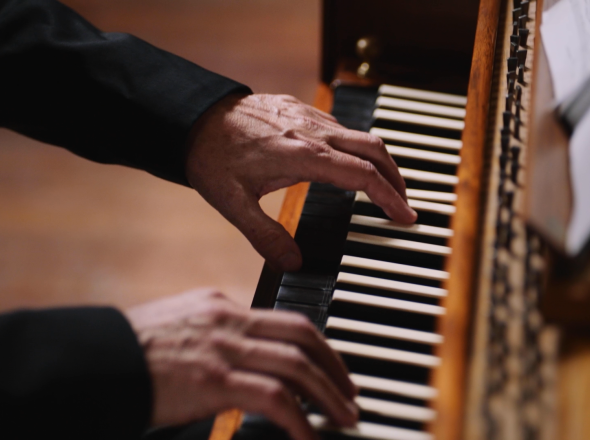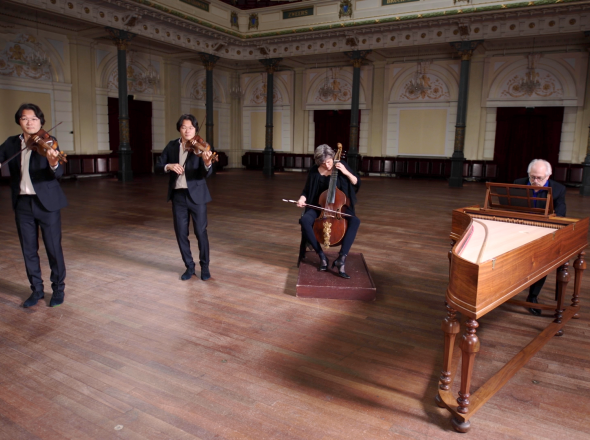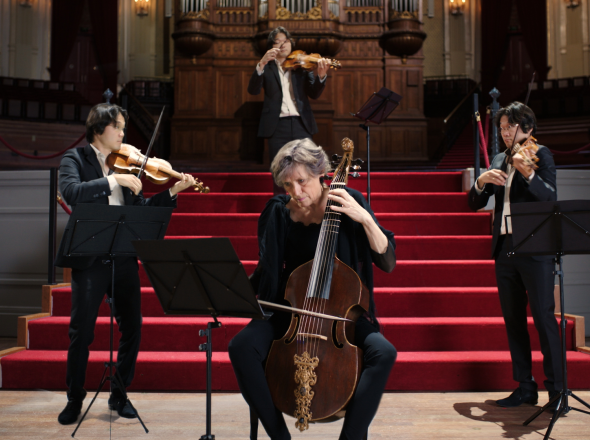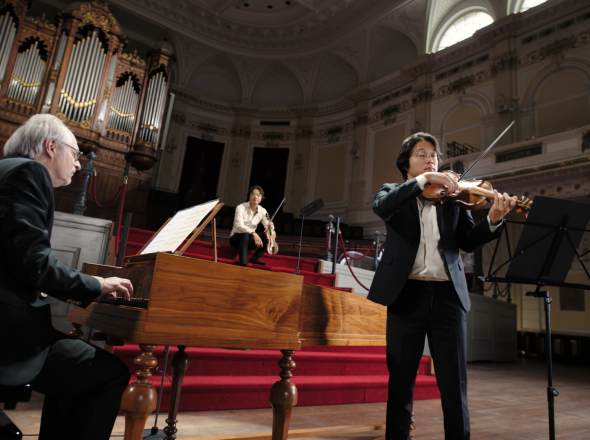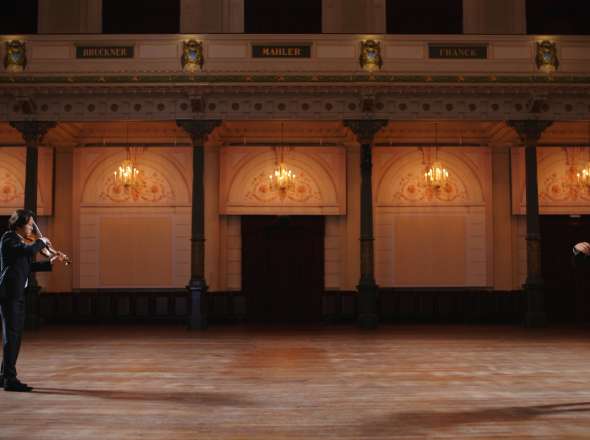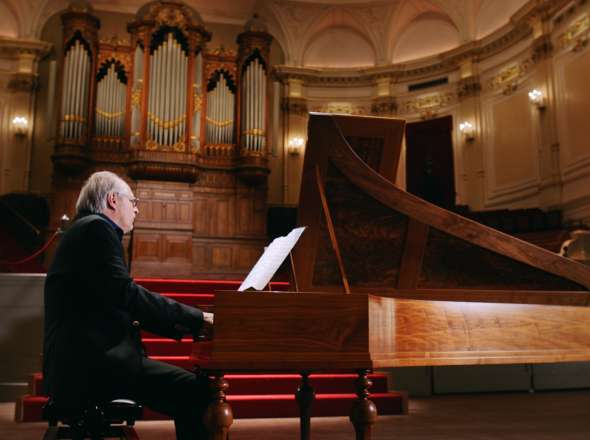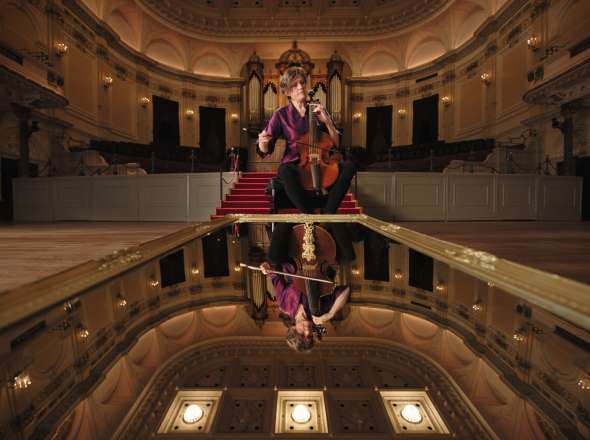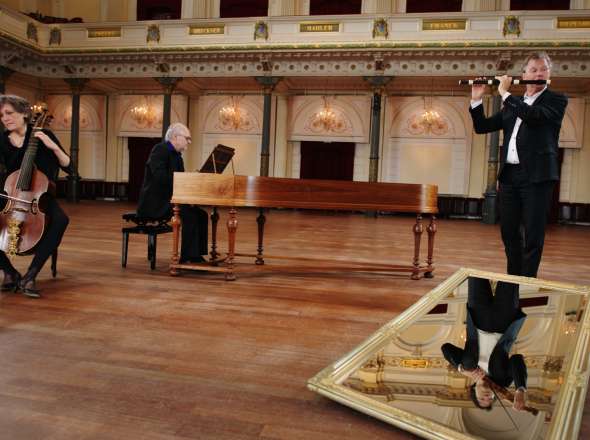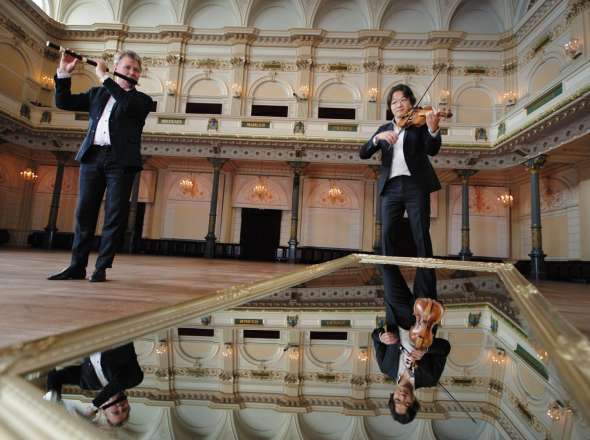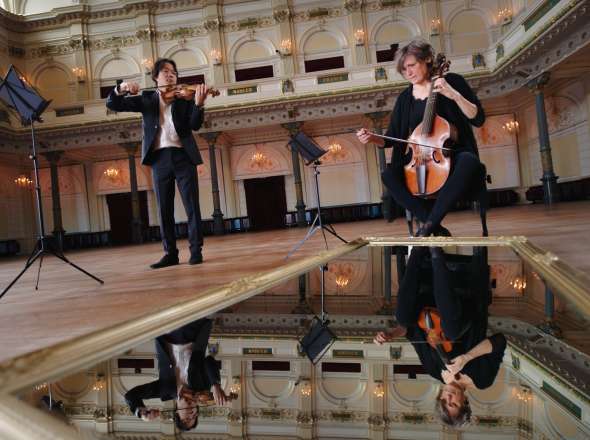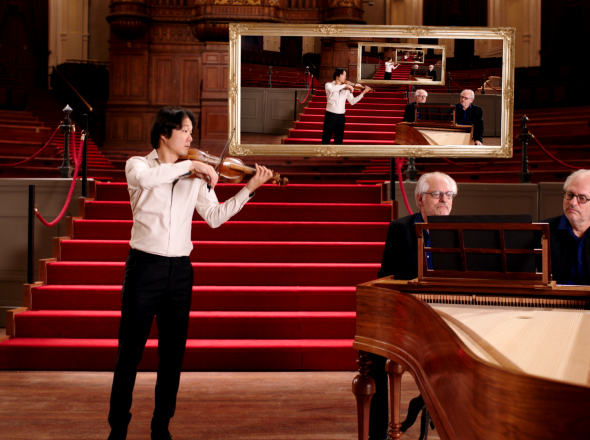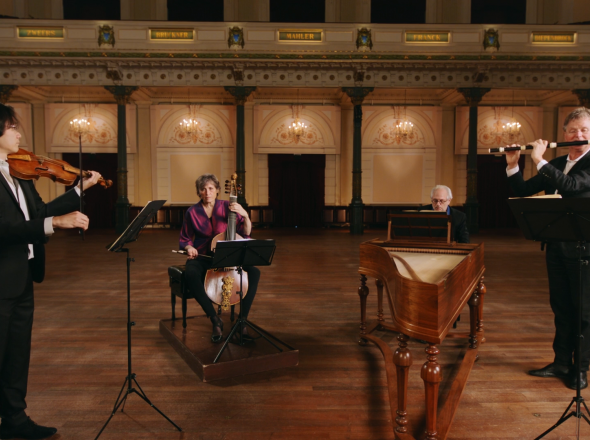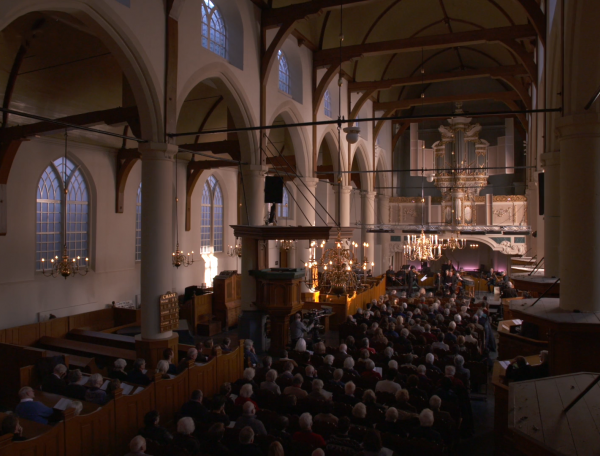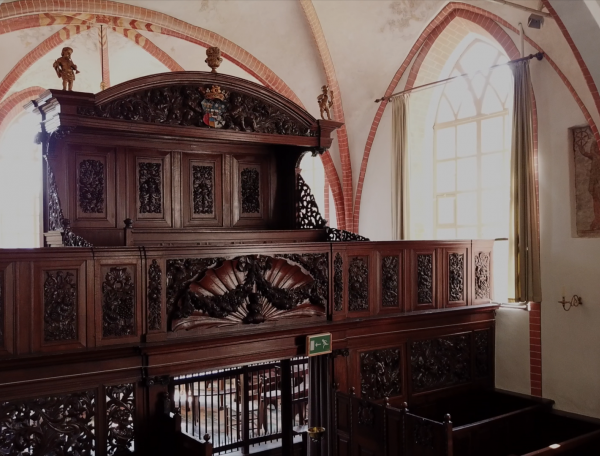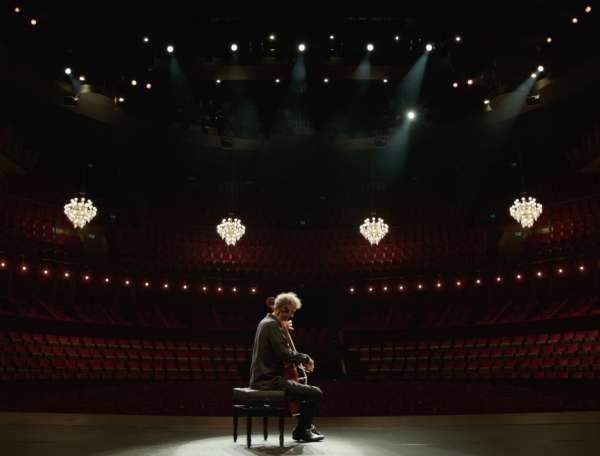
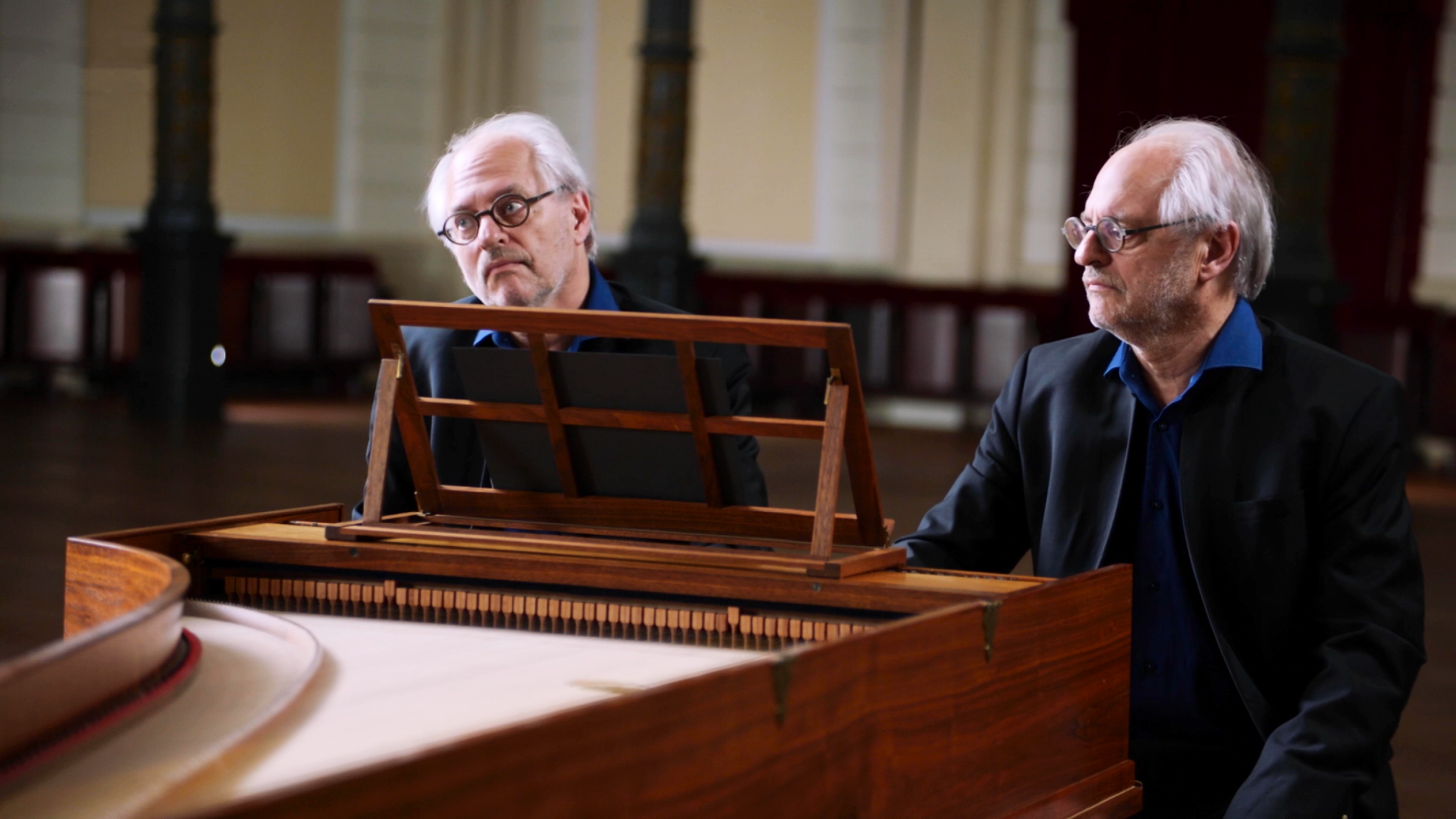
Canon perpetuus super Thema Regium from Musikalisches Opfer
BWV 1079/10 performed by Mieneke van der Velden and Leo van Doeselaar
Het Concertgebouw, Amsterdam
Behind the music
One part for two pianists
The canon perpetuus super thema regium has no clear ending
Canons – pieces of music whereby one part is notated from which several voices can then be derived – come in all shapes and sizes. They may be very simple, like the song Frère Jacques, but also extremely complex. The ten canons in Bach’s Musikalisches Opfer range from those that are solved fairly simply to ingenious puzzles.
First let’s look at the title of this canon. It is ‘perpetuus’ (perpetual) and ‘per thema regium’ (on the royal theme). Nearly all canons can be repeated endlessly, but Bach may have specifically referred to it here because there is no ‘logical’ ending to this piece. The canon is notated on two staves, with the royal theme above and the counterpart on the stave below with two keys at the beginning: one treble clef and one bass clef. A sign indicates when the lower part (played in this case on a Silbermann fortepiano) can double itself. So that’s why we see Leo van Doeselaar playing twice on the same instrument.

Musikalisches Opfer, BWV 1079
The Musikalisches Opfer is a special collection of chamber music within the work of Johann Sebastian Bach, written for Frederick the Great of Prussia. Musikalisches Opfer means ‘a musical offering’, and that is precisely how the collection originated.
It all started in May 1747, when Bach went to Potsdam to visit his son Carl Philipp Emanuel, who was working at the court of Frederick the Great. Bach was introduced to Frederick, who had heard that Bach was a great improviser and asked him on the spot to improvise a fugue on a given theme (undoubtedly a first shot at the Ricercar a 3). According to the sources, Bach made a brilliant job of it and showed such enthusiasm about the ‘royal theme’ that he promised to have the fugue engraved ‘on copper’ and printed.
No sooner said than done. Two months later, Bach published a series of compositions: a trio sonata, a three-part and a six-part ricercar and ten canons, all inspired by the king’s theme. Frederick was sent a splendid luxury print and Bach distributed his masterpiece among his friends, despite the high costs of printing. Incidentally, Bach himself did not call the collection Musikalisches Opfer, but rather Regis Iussu Cantio Et Reliqua Canonica Arte Resoluta (the theme given by the king, with additions, resolved in canonic style). The initials of this long title form the term ricercar, a name used at the time for an instrumental piece in which various themes are introduced and imitated.
For Frederick the Great, Bach played on a Silbermann fortepiano, which was a brand-new instrument at the time. Bach was enthusiastic about it and later acted as representative for Silbermann in Leipzig. So for the recording, we have also used a Silbermann fortepiano. Alongside this modern instrument, Shunske Sato has chosen to have the continuo played by a gamba; an instrument that also played a big role at the court of Frederick. ‘Modern’ instruments for the time thus play alongside ‘old-fashioned’ instruments, just as in the Musikalisches Opfer Bach combines the modern galant style with the counterpoint that was then considered old-fashioned.
The canons in the Musikalisches Opfer are a sort of visual music. Bach wrote them like puzzles, which the player must first solve in order to play them correctly. In these recordings, we wanted to give a literal picture of this ‘visual music’. So for example, wherever a part is doubled, the player will be in view twice. And where a part is mirrored, then the player appears in a mirror too.
Bach on the piano
For Frederick the Great, Bach played on a Silbermann fortepiano, which was a brand-new instrument at the time. Bach was enthusiastic about it and later acted as representative for Silbermann in Leipzig. So for the recording, we have also used a Silbermann fortepiano. Alongside this modern instrument, Shunske Sato has chosen to have the continuo played by a gamba; an instrument that also played a big role at the court of Frederick. ‘Modern’ instruments for the time thus play alongside ‘old-fashioned’ instruments, just as in the Musikalisches Opfer Bach combines the modern galant style with the counterpoint that was then considered old-fashioned.
- BWV
- 1079/10
- Title
- Canon perpetuus super thema regium
- Instrument
- viola da gamba, fortepiano
- Genre
- chamber music
- Year
- 1747
- City
- Leipzig
- Occasion
- written for Frederick the Great
With support from
Extra videos
Vocal texts
Original
Translation
Credits
-
- Release date
- 13 May 2021
-
- Recording date
- 6 July 2020
-
- Location
- Het Concertgebouw, Amsterdam
-
- Viola da gamba
- Mieneke van der Velden
-
- Instrument
- Antoine Despont, 1617
-
- Fortepiano
- Leo van Doeselaar
-
- Instrument
- Thomas and Barbara Wolf, 1997/1998 after Gottfried Silbermann, 1746
-
- Director and editor
- Onno van Ameijde
-
- Music recording
- Guido Tichelman, Bastiaan Kuijt, Pim van der Lee
-
- Music edit and mix
- Guido Tichelman
-
- Camera
- Onno van Ameijde, Jeroen Simons
-
- Lights
- Emile Groenewoud
-
- Lighting assistant
- Erwin Smit, Aden Zijp
-
- Data handling
- Stefan Ebels
-
- Assistant music recording
- Marloes Biermans
-
- Producer
- Jessie Verbrugh
-
- With support from
- MWH4impact
Musikalisches Opfer
The Musikalisches Opfer is a special collection of chamber music within the work of Johann Sebastian Bach, written for Frederick the Great of Prussia, and consists of a total of 13 movements.
Discover
Help us to complete All of Bach
There are still many recordings to be made before the whole of Bach’s oeuvre is online. And we can’t complete the task without the financial support of our patrons. Please help us to complete the musical heritage of Bach, by supporting us with a donation!
